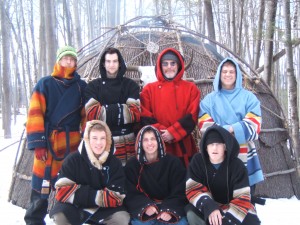Living Deep & Sucking Out the Marrow

Originally appears in the Fall 2015 issue
When Henry David Thoreau offered an explanation on what he was about in his Walden experiment in chapter two of his book[i], he stated that he wished “to live deep and suck out all the marrow of life” while routing out “all that was not life”. For twenty-four years now I have been attempting to follow Thoreau’s wisdom while being charged with teaching field biology to the high school students in my care. For Thoreau, his path was clearly one of immersive experience within nature, or what he would call a “natural life”. I have imagined students, and myself, as wildcrafters of that natural life, preferring the term wildcrafting to educate, which means to draw out. Wild crafting refers to gathering natural products directly from natural areas untouched by man; Herbalists gather herbs, or simples; basket makers their materials for making baskets. Yet there is an older and wiser understanding of this term that denotes the cultivation of a wisdom and understanding gained through direct experience with Nature – or Thoreau’s natural life. I have developed the Naturalist Program (a place based field ecology elective utilizing primitive skills, wilderness adventures, and rites-of passage experiences) at the High Mowing School with these aims in mind – going deep into the nature of experience, where Thoreau’s dictum to “try our lives by a thousand simple tests” and approached as “an experiment to a great extent untried by me” are met as part of our daily educational fare.
To view the photo-rich magazine version, click here.
If you are not already a subscriber, please subscribe to read the full article
Keith Badger has been teaching at the High Mowing School in Wilton, New Hampshire for the past 24 years, where he has developed, and directs, the school’s Naturalist Program. He has much more to share within the myriad avenues utilized to bring learning and life alive! He loves to hear about others and can be contacted at badgertrack@tds.net.
Resources
- Culin, Stewart, Games of The North American Indians, Dover 1975
- Elbroch, Mark, Mammal Tracks & Sign: A Guide to North American Species, Stackpole 2003
- Elpel, Thomas, Participating in Nature, HOPS Press 1999
- Gaty, Harold, Finding Your Way Without Map or Compass, Dover 1958
- Hamm, Jim (Editor), The Traditional Bowyer’s Bible: Volume One, Bois d’Arc Press1992
- Kricher, John C., A Field Guide to Eastern Forests (Peterson Field Guide Series), Houghton Mifflin 1988
- Keen, Jake, A Teacher’s Guide to Ancient Technology, English Heritage 1996
- Kochanshi, Mors, Bushcraft: Outdoor Skills and Wilderness Survival, Lone Pine Press 1987
- Leslie, Clare Walker, Keeping a Nature Journal. Storey 1998
- Liebenberg, Louis, The Art of Tracking: The Origin of Science, David Philip Publishers 1990
- Nabokov, Peter and Easton, Robert, Native American Architecture, Oxford University Press, 1989
- Neddo, Nick, The Organic Artist: Make Your Own Paint, Paper, Pigments, Prints, and More from Nature, Quarry Books 2015
- Richards, Matt, Deerskins Into Buckskins: How to Tan with Natural Materials, Backcountry Publishing 1997
- Wescott, David (Editor), Primitive Technology: A Book of Earth Skills, Gibbs Smith1999
- Wescott, David (Editor), Primitive Technology II: Ancestral Skills, Gibbs Smith 2001
- Young, Jon, Haas, Ellen, McGown, Evan, Coyote’s Guide To Connecting With Nature, Owlink Media 2010
- Young, Jon & Morgan, Tiffany, Animal Tracking Basics, Stackpole 2007
Notes
[i] Thoreau, Henry David Walden, Houghton Mifflin Company, 1949.
[ii] Thoreau, Henry David A Week on the Concord and Merrimack Rivers, Princeton University Press, 1980.
[iii] Campbell, Joseph, The Hero With A Thousand Faces, Joseph Campbell Foundation, Third Edition, 2008.
Leave a Reply
You must be logged in to post a comment.










